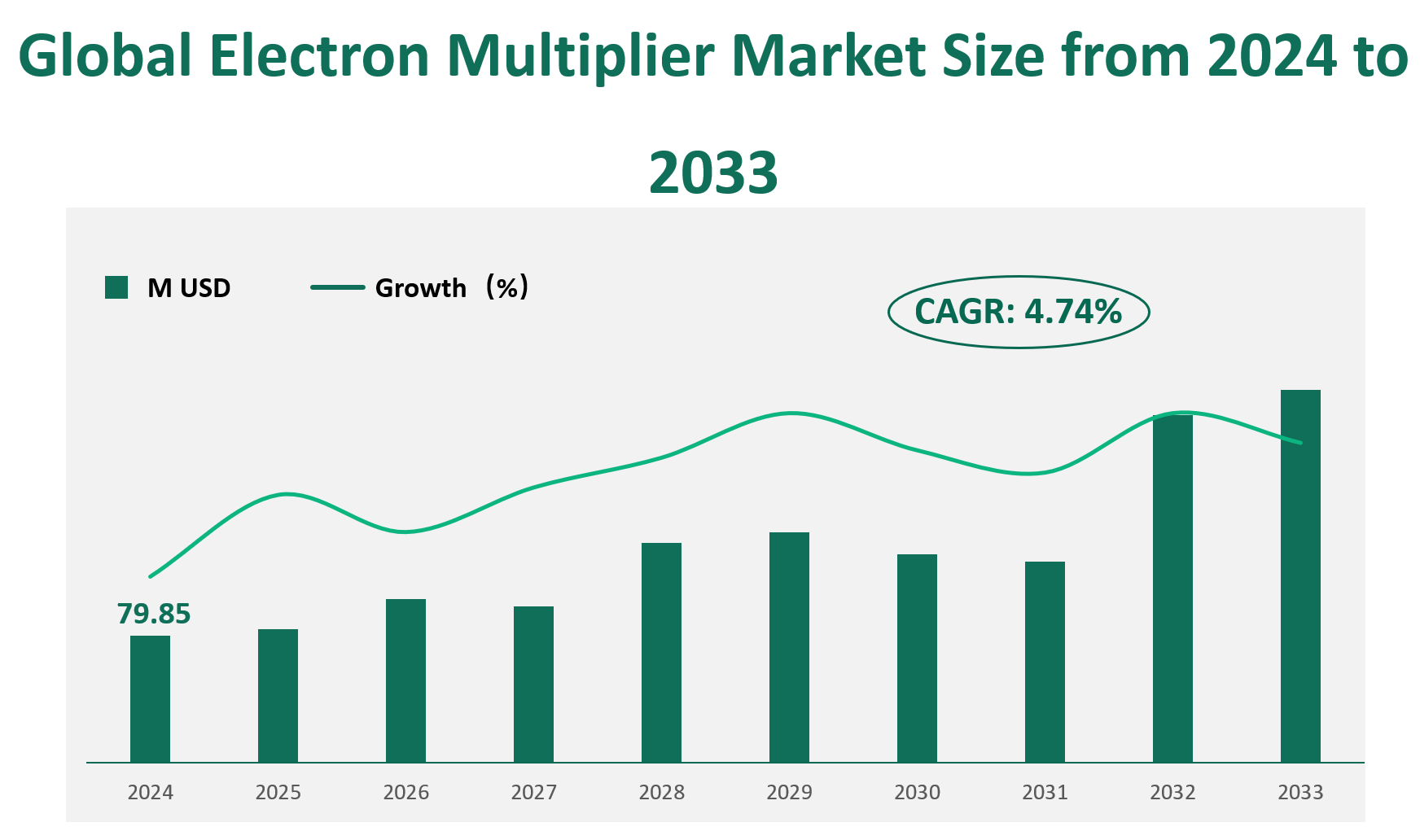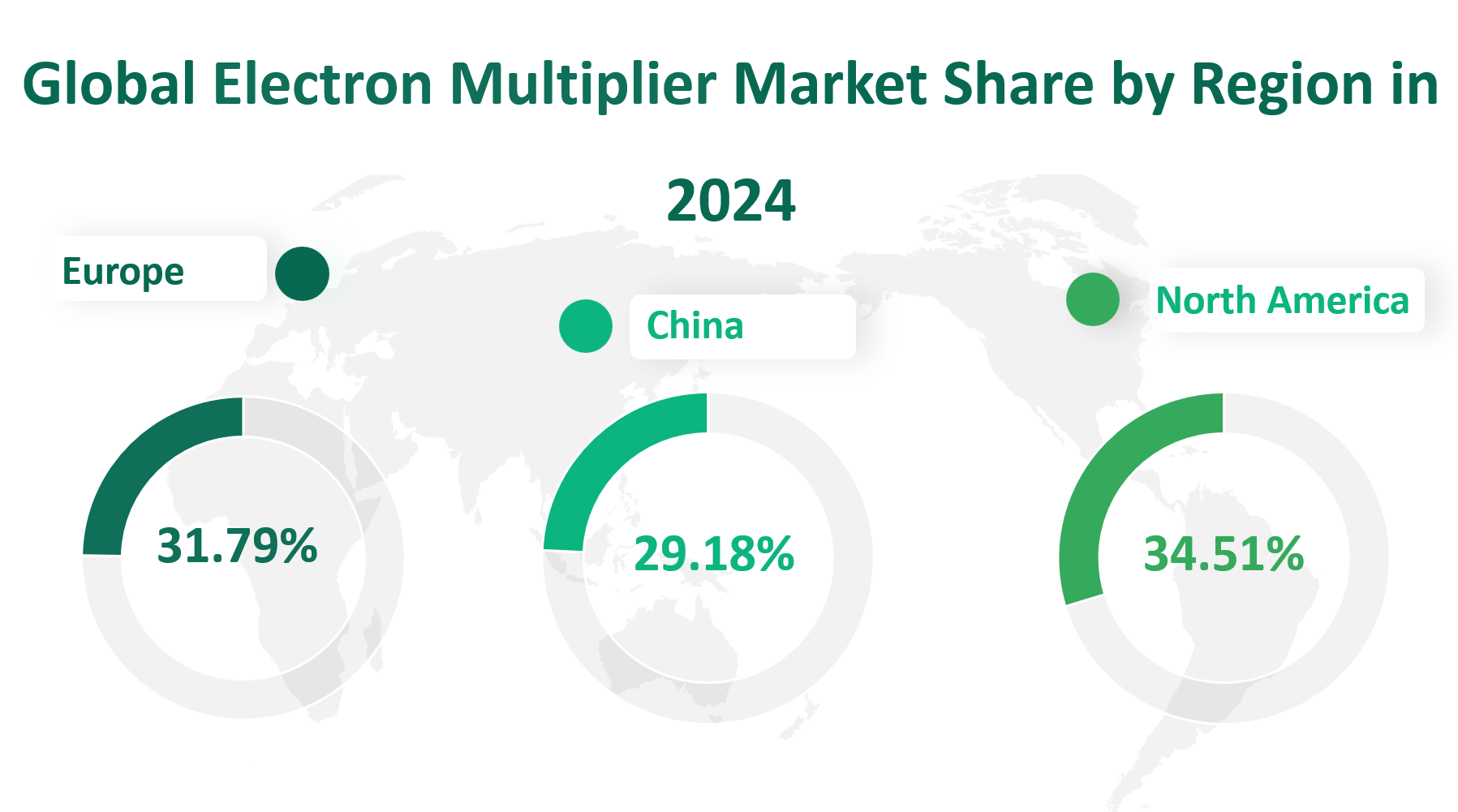1. Global Electron Multiplier Market Insight Analysis
The global revenue for the Electron Multiplier market reached $79.85 million in 2024, with a Compound Annual Growth Rate (CAGR) of 4.74% from 2024 to 2033.
An Electron Multiplier is a vacuum-tube structure designed to amplify incident charges through a process known as secondary emission. When a single electron strikes a secondary-emissive material, it induces the emission of approximately 1 to 3 additional electrons. By applying an electric potential between successive metal plates, these emitted electrons are accelerated to induce further secondary emissions, resulting in a cascade of electrons collected by a metal anode. This amplification process allows for the detection of very weak signals, making Electron Multipliers essential components in various scientific instruments.
Figure Global Electron Multiplier Market Size (M USD) and CAGR (2024-2033)

2. Driving and Limiting Factors of Electron Multiplier Market Growth
The growth of this market is primarily driven by several key factors. Firstly, the increasing demand for mass spectrometry technology and related instruments is a significant driver. Mass spectrometry is a powerful analytical technique used to identify and quantify molecules based on their mass-to-charge ratio. The ability of Electron Multipliers to amplify weak signals makes them essential components in mass spectrometers, driving their market demand.
Secondly, technological advancements in scientific instruments are fueling market growth. Innovations in technology, such as improved sensitivity and durability, are enhancing their performance and expanding their applications. Governments and research institutions worldwide are investing in the development of advanced analytical instruments, providing strong support for the market.
Lastly, the growing importance of environmental monitoring and healthcare diagnostics is driving the need for precise analytical tools. Electron Multipliers are used in instruments that detect pollutants in the environment and biomarkers in medical diagnostics, contributing to their increasing market demand.
Despite the growth drivers, the Electron Multiplier market faces several challenges. One significant challenge is the high cost of raw materials and production difficulties. The manufacturing process of Electron Multipliers requires specialized materials and precise engineering, which can be expensive and technically demanding. This limits the market’s ability to scale production rapidly.
Another limiting factor is the presence of alternative technologies. For instance, ion counters and induced charge detectors are alternative detectors used in mass spectrometry, which can compete with Electron Multipliers in certain applications. The availability of these alternatives can reduce the market share of Electron Multipliers.
3. Technology Innovation and Corporate Mergers and Acquisitions in Electron Multiplier Market
Technological innovation is a key driver of the market. Companies are continuously investing in research and development to improve the performance and reliability of Electron Multipliers. For example, advancements in materials science and microfabrication techniques are enabling the development of more efficient and durable Electron Multipliers. These innovations are crucial for meeting the increasing demands of high-precision analytical instruments.
Corporate mergers and acquisitions are also shaping the market landscape. Major players in the Electron Multiplier market are engaging in strategic partnerships and acquisitions to expand their product portfolios and enhance their market positions. For instance, Agilent Technologies’ acquisition of BioTek Instruments and Hamamatsu Photonics’ acquisition of Energetiq Technology are examples of such strategic moves. These acquisitions allow companies to integrate complementary technologies and strengthen their market presence.
4. Global Electron Multiplier Market Size by Type
Electron Multipliers are devices designed to amplify weak electrical signals by multiplying incident charges through a process known as secondary emission. They are categorized into two primary types: Vacuum type and Gas type.
Vacuum type operate in a vacuum environment, where electrons are accelerated and multiplied through a series of dynodes. These devices are known for their high sensitivity and low noise, making them ideal for applications requiring high precision and accuracy. The Vacuum Electron Multiplier segment is projected to have a significant market share in 2024. The market revenue for this type is expected to reach approximately $56.65 million.
Gas type, on the other hand, operate in a gaseous environment and utilize the ionization of gas molecules to amplify signals. These multipliers are known for their robustness and ability to operate under less stringent vacuum conditions. The market revenue for Gas Electron Multipliers in 2024 is projected to be around $23.20 million.
Table Global Electron Multiplier Market Size by Type in 2024
5. Global Electron Multiplier Market Size by Application
MALDI is a technique used in mass spectrometry to analyze large biomolecules such as proteins and peptides. Electron Multipliers are integral to this application, providing the necessary sensitivity to detect low-abundance ions. In 2024, the market revenue in MALDI applications is projected to reach $31.45 million.
Ionization Time-of-Flight Mass Spectrometry (TOF-MS) is another key application area for Electron Multipliers. This technique is used to analyze ions based on their time of flight, providing high-resolution mass spectra. The market revenue in TOF-MS applications in 2024 is expected to be around $18.21 million.
Residual Gas Analyzers (RGAs) are used to monitor the composition of gases in vacuum systems, ensuring optimal operating conditions. Electron Multipliers are essential components in RGAs, providing the sensitivity needed to detect trace amounts of residual gases. The market revenue in RGA applications in 2024 is projected to be $14.69 million.
GC/LC-MS is a powerful analytical technique used to separate and detect compounds in complex mixtures. Electron Multipliers are used in these systems to amplify the ion signals, enabling the detection of trace amounts of analytes. The market revenue in GC/LC-MS applications in 2024 is expected to be $9.65 million.
Electron Spectrometers are used to analyze the energy distribution of electrons emitted from a sample, providing information about the sample’s electronic structure. Electron Multipliers play a crucial role in these instruments by amplifying the electron signals. The market revenue in electron spectrometry applications in 2024 is projected to be $2.78 million. While this segment has a smaller market share, it is experiencing steady growth due to the increasing demand for advanced materials characterization.
Scanning Electron Microscopy (SEM) is a widely used technique for imaging surfaces at high resolution. Electron Multipliers are used in SEMs to detect secondary electrons emitted from the sample, providing detailed surface information. The market revenue in SEM applications in 2024 is expected to be $1.94 million.
Table Global Electron Multiplier Market Size by Application in 2024
Application | Market Size (M USD) 2024 |
Matrix Assisted Laser Analysis | 31.45 |
Lonization Time of Flight Mass Spectrometer | 18.21 |
Residual Gas Analyzer | 14.69 |
GC or LC MS | 9.65 |
Electron Spectrometer | 2.78 |
Scanning Electron Microscope | 1.94 |
Others | 1.13 |
6. Global Electron Multiplier Market by Top Regions
North America remains the largest regional market by revenue, accounting for approximately $27.55 million in 2024. This region’s dominance is attributed to its advanced technological infrastructure, strong presence of leading manufacturers, and high demand for precision analytical instruments. The United States, in particular, drives this market due to its robust research and development ecosystem and significant investments in scientific instrumentation.
Europe follows closely with a market revenue of $25.39 million in 2024. The region benefits from a high concentration of research institutions, stringent quality standards, and a well-established industrial base.
Asia-Pacific: The Asia-Pacific region is the fastest-growing market, with a projected revenue of $23.3 million in 2024. This growth is fueled by rapid industrialization, increasing demand for high-tech analytical instruments, and significant investments in research and development. China and Japan are key players in this region, with China’s expanding manufacturing sector and Japan’s technological prowess driving the market forward.
South America: South America’s market revenue is estimated at $2.62 million in 2024. Although smaller in scale, the region is experiencing steady growth due to increasing industrial activities and investments in scientific research.
Middle East and Africa: The Middle East and Africa region accounted for $0.99 million in 2024. While this region is relatively small, it holds potential for future growth, particularly in the Middle East, where investments in advanced technologies and infrastructure are on the rise.
Figure Global Electron Multiplier Market Size by Region in 2024

7. Global Electron Multiplier Market Analysis by Major Players
7.1 Adaptas
Introduction and Business Overview: Adaptas, headquartered in the United States, is a leading manufacturer of Electron Multipliers. Founded in 1983, the company specializes in the production of continuous dynode and discrete dynode Electron Multipliers. Adaptas has a global presence, with facilities in the US and Australia, and serves a wide range of industries, including mass spectrometry and electron microscopy.
Products: Adaptas offers a variety of Electron Multipliers under the DeTech, Scientific Instrument Services, and ETP Ion Direct brand names. Their products are known for high performance, reliability, and customization capabilities.
7.2 Hamamatsu
Introduction and Business Overview: Hamamatsu, based in Japan, is a global leader in the production of Electron Multipliers and other photonics products. Established in 1953, the company has a strong reputation for innovation and high-quality manufacturing. Hamamatsu’s products are widely used in medical, scientific, and industrial applications.
Products: Hamamatsu offers a range of Electron Multipliers designed for detecting electrons, ions, and other charged particles. Their products are known for their high gain, low noise, and excellent sensitivity.
7.3 PHOTONIS
Introduction and Business Overview: PHOTONIS, headquartered in France, is a renowned manufacturer of Electron Multipliers and other electro-optic components. Founded in 1937, the company has a long history of innovation and serves a diverse range of industries, including mass spectrometry, night vision, and medical imaging.
Products: PHOTONIS is known for its Channeltron® Electron Multipliers, which offer high dynamic range and linear response. Their products are used in various applications, including residual gas analysis and electron microscopy.

